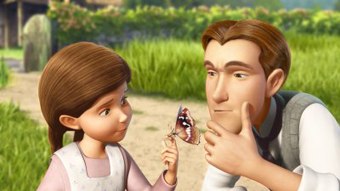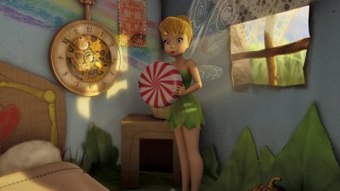The director of the latest Tinker Bell movie discusses a new wrinkle with human interaction.
Check out the Tinker Bell and the Great Fairy Rescue trailers at AWNtv!
Tinker Bell and the Great Fairy Rescue marks the third in the cycle of four home entertainment features, which finishes its two-week Oscar-qualifying theatrical run at the El Capitan Theatre this week before bowing on Blu-ray and DVD on Sept. 21st from Walt Disney Home Ent. This time out, Tinker Bell partners with her rival fairy in order to keep secret their existence from humans. Bradley Raymond helms from a script by Bob Hilgenberg and Rob Muir. Mae Whitman (Scott Pilgrim) voices Tink, with guest appearances by Michael Sheen, Lucy Liu, Raven-Symone and Rob Paulsen.
Bill Desowitz: You directed the first Tinker Bell movie, which sets up the origin story, so what's different about this third movie?
Bradley Raymond: What's different about this one is I wanted to tell a story about what it would be like to meet a fairy. I love telling wish-fulfillment stories about ordinary characters who have extraordinary things happen to them and I thought it would be fun to see Tinker Bell meet a human for the first time. And we go into the point of view of a human and what it would be like to meet a fairy. I was inspired by Peter Pan and that moment where Wendy got to go to Neverland and meet Peter Pan and Tinker Bell.
BD: What else did you want to explore with the characters?
BR: In telling the first story, Tinker Bell learns how to be a fairy, and I love seeing the rivalry with Vidia [Pamela Adlon], who's aloof and somewhat of an outsider; and now Vidia continues to be agitated by Tinker Bell and must rescue her, and she bonds with everybody.
BD: What are some of the highlights for Tinker Bell?
BR: Well, in the first one, we got to see her origin story and see her fascination with human objects -- we call them "Lost Things." Then we get to see those firsts, like she didn't know that she sounds like a jingling bell to humans and she learns this when interacting with Lizzy, and she teaches her how to fly. So it's very interesting to see how the audience knows more information than the character and makes for a greater connection.
BD: So it's really about Lizzy and her father, Dr. Griffiths?
BR: Yes, they're voiced by Lauren Mote, who is this wonderful 14-year-old English actress, and Michael Sheen. Coming from live-action, a lot of the acting comes from their eyes and face, and to be able to act with just your voice is a different type of art form, and he picked it up right away. He was so natural and is a fascinating actor, so he really got the character right away; he helped create how he would come across and be more likable. He was able to capture that warmth that we needed.
BD: He got a little taste of voice acting on Tim Burton's Alice in Wonderland as the White Rabbit.
BR: We were actually recording with him while he was recording Alice, also, on different days.
BD: He's the skeptic about fairies.
BR: Yes, he has to learn how to believe in his daughter -- to have interest in what she's interested in. He's a scientist busy with his job and gathering butterflies for an exhibit, but he has a sense of wonder about science, and so when you first meet them and they're looking at a mis-painted butterfly, he thinks it's a scientific reason and Lizzy thinks it's because of fairies. So, to see him realize that everything she's been saying is true, is a wonderful moment, and people who've seen the movie have been talking about wanting to spend time with their children more.
BD: And Tinker Bell's role in all of this?
BR: It's interesting: I call Tinker Bell a catalyst character, so she arcs other characters.
BD: Like a traveling angel.
BR: Yes, absolutely. And she wants to know why fairies can't get closer to humans. And she pulls everyone along for the ride to see that humans are not that bad once you get to know them. So it's a nice contrast to see the fairies running away from the humans in the beginning and [later] having a tea party with them.
BD: What is characteristic of the summer look?
BR: There is so much to do during summer from a fairy point of view: flowers that open at night and close in the day, and flowers that open during the day and close at night; they stay at Fairy Camp on the mainland the whole summer. And the fantastical look of Pixie Hollow, inspired by Mary Blair of Peter Pan, I wanted to look a little more realistic -- not as designy -- to give you a sense of looking at a more relatable world, where the magical things happening to Lizzy are happening to the audience at the same time.
BD: And what were some of the animation challenges?
BR: There were some big challenges. Stepping into the project, I was told everything I wanted to do would not be possible with the time we had, but, actually, all of those things ended up in the movie. The one challenge for animation was that the human characters were not cartoony and believable in their acting and Sheryl Sackett is our animation director and she worked with our team, and Tinker Bell really does feel believable, and as far as effects, when Vidia gets wet when the valve under the car gets turned on, it's an extremely hard thing to do, but they pulled it off. You needed that for the humor. And fur is such a difficult thing, and we have a cat that gets wet. And when Silver Mist turns the waterfall sideways to stop the boat from crashing, was also challenging -- one of the last shots we got in.
BD: What improvements did John Lasseter suggest?
BR: Yes, one of the things in this movie is that Tinker Bell hides from Lizzy and her father when they're having an argument about whether fairies are real, and I was going to play Tinker Bell coming out of the fairy house nervous and afraid, proving the father's point. And John said that Tinker Bell would already be bonded with Lizzy and would be angry, turn red and confront the dad. And that was more in character with Tinker Bell, and that's what John Lasseter brings: it seems so natural, so it's been like going back to film school with him.
Bill Desowitz is senior editor of AWN & VFXWorld.












